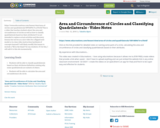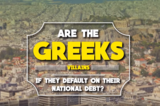
This is a lesson about head and face features in Arabic
- Subject:
- Arts and Humanities
- Material Type:
- Activity/Lab
- Lecture
- Lesson Plan
- Date Added:
- 11/24/2013

This is a lesson about head and face features in Arabic

Master the Arabic Letters is a video series consisting of eight videos that introduce viewers to the names, shapes, and sounds of the Arabic letters. The videos also explain how to join up the letters in writing and make sure that differences in pronunciation are carefully demonstrated.

This site contains numerous audio, and video files, grouped by topic, of subjects speaking Jordanian colloquial Arabic. There are also a few images and informational links interspersed throughout the site. Each video is available for download and accompanied by an Arabic transcript and an English translation. Videos are based on every day topics like greetings, farewells, shopping, and transportation.

This short video and interactive assessment activity is designed to teach third graders about creating largest and smallest numbers given digits.

In which John Green teaches you about the war that was supposed to end all wars. Instead, it solved nothing and set the stage for the world to be back at war just a couple of decades later. As an added bonus, World War I changed the way people look at the world, and normalized cynicism and irony. John will teach you how the assassination of an Austrian Archduke kicked off a new kind of war that involved more nations and more people than any war that came before. New technology like machine guns, airplanes, tanks, and poison gas made killing more efficient than ever. Trench warfare and modern weapons led to battles in which tens of thousands of soldiers were killed in a day, with no ground gained for either side. World War I washed away the last vestiges of 19th-century Romanticism and paved the way for the 20th-century modernism that we all know and find to be cold and off-putting. While there may not be much upside to WWI, at least it inspired George M. Cohan to write the awesome song, "Over There."
Chapters:
Introduction: The Great War
Causes of World War I
Who is to blame for starting WWI?
Trench Warfare
Combatants From Around the World
Casualties of World War I
Soldiers' Sentiments During the WWI
An Open Letter to Alcohol
Outcomes of WWI
Credits

This week on Crash Course Mythology, Mike is teaching you about the archetypes that are often associated with male divinities. We’re going to talk about Fathers & Sons, Kings & Judges, Saviors & Sages, Shamans, Tricksters, and Lords of Destruction. Along the way, we’ll look at the story of Hwaning, Hwanung, and Dangun from the Korean peninsula, and we’ll learn about Arjuna and all the help he got from Krishna. We’ll also touch on a ton of other myths from around the world. These things play out this way all the time, man.

See the many birds that spend their summer in the Arctic in this video segment from Nature.

Climate change has no bias, but our societies and systems do. And although it’s a danger to all of us, a changing climate affects some groups disproportionately, raising issues of justice and equity. In this episode of Crash Course Climate and Energy, we’ll take a look at the ways injustice within societal structures causes climate change to affect some more than others and discuss some of the work that environmental justice advocates are doing in response.
Chapters:
Introduction: The Rohingya & Climate Inequality
How Climate Affects Our Lives
Climate Justice
Redlining & Climate Inequality
Social Inequality & The Climate
Renewable Energy & Inequality
Review & Credits
Credits

This learning video deals with a question of geometrical probability. A key idea presented is the fact that a linear equation in three dimensions produces a plane. The video focuses on random triangles that are defined by their three respective angles. These angles are chosen randomly subject to a constraint that they must sum to 180 degrees. An example of the types of in-class activities for between segments of the video is: Ask six students for numbers and make those numbers the coordinates x,y of three points. Then have the class try to figure out how to decide if the triangle with those corners is acute or obtuse.

https://www.educreations.com/lesson/view/area-of-circles-and-quadrilaterals/18914894/?s=uT6vGf
This is a video that teaches students about the area and circumference of circles as well as how to classify quadrilaterals based on their attributes! It is not intended to replace actual activities and discovery lessons but serves as a nice video for a flipped note model or in class video instruction/synthesis of concepts learned!
I will likely modify this lesson to include a "fill in the blank" for my students. If I do this, I will add it to this site momentarily.

This lesson is based on the results of a performance task in which we realized that students' understanding of area and perimeter was mostly procedural. Therefore the purpose of this re-engagement lesson was to address student misconceptions and deepen student understanding of area and perimeter. The standards addressed in this lesson involve finding perimeter and area of various shapes, finding the perimeter when given a fixed area, and using a formula in a practical context. Challenges for our students included decoding the language in the problem and proving their thinking. (7th Grade Math)

This short video and interactive assessment activity is designed to give fourth graders an overview of composite figures composed of squares and rectangles.

This short video and interactive assessment activity is designed to teach third graders about area in grid.

This short video and interactive assessment activity is designed to give fourth graders an overview of area and perimeter of rectangle.

What happens when governments default on their debts? In this video, Professor Garrett Jones of George Mason University uses the Greek government debt crisis to explain what happens when governments default on their debts and why it's not always a bad thing.

This resource is to introduce the writing of a thesis statement and introduction for a research essay.

This resource is designed to walk students through the process of completing a research project in any field of study. It covers the earliest stages of brainstorming and discussing, continues through researching and compiling sources; writing, documenting, revising, and polishing a paper; and finally presenting the research topic to a wider audience in a professional manner. The focus is on MLA format, though the course could be modified for other formats.
The first unit is an introduction to the project. It asks students to draw on knowledge of issues affecting their own community and world to help generate discussion that could eventually lead to a research topic.

This resource is designed to walk students through the process of completing a research project in any field of study. It covers the earliest stages of brainstorming and discussing, continues through researching and compiling sources; writing, documenting, revising, and polishing a paper; and finally presenting the research topic to a wider audience in a professional manner. The focus is on MLA format, though the course could be modified for other formats.
The first unit is an introduction to the project. It asks students to draw on knowledge of issues affecting their own community and world to help generate discussion that could eventually lead to a research topic.

This video goes over the basics of a 5-paragraph argumentative paper, including the rebuttal. There are examples for each paragraph (introduction + thesis, body paragraphs, rebuttal paragraph, and conclusion).

This video will explain the case for protectionism. This 14 minute video will enforce standards EPF. 9 and particularly EPF. 9 (e).